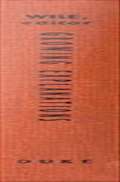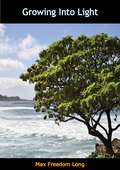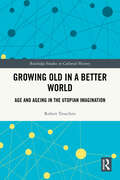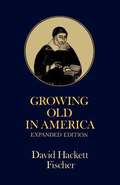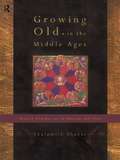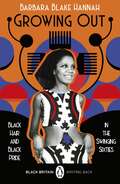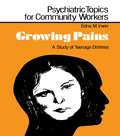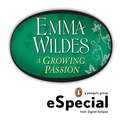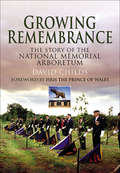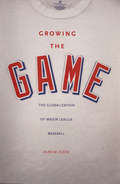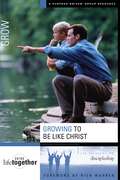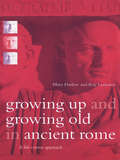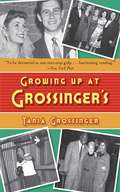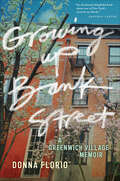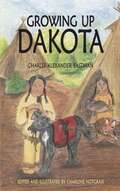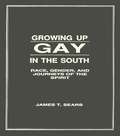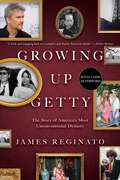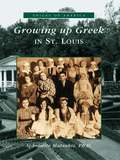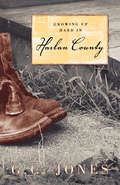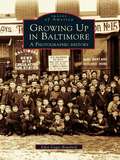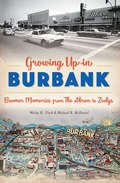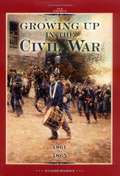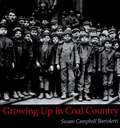- Table View
- List View
The Growing Economy: Principles of Political Economy Volume II (Collected Works of James Meade)
by James E. MeadeFirst published in 1968, this is the second part of Professor Meade’s Principles of Political Economy, which presents a systematic treatment of the whole field of economic analysis in the form of a series of simplified models which are specifically designed to show the interconnections between the various specialist fields of economic theory. In this volume, Professor Meade is concerned with the theory of economic growth and the rates at which various economic quantities are growing. In order to do this, he introduces capital goods into the system and allows for growth through capital accumulation, population expansion and technical progress. His analysis is divided into two models: a one product model and a many-product model.
Growing Explanations: Historical Perspectives on Recent Science
by M. Norton WiseFor much of the twentieth century scientists sought to explain objects and processes by reducing them to their components--nuclei into protons and neutrons, proteins into amino acids, and so on--but over the past forty years there has been a marked turn toward explaining phenomena by building them up rather than breaking them down. This collection reflects on the history and significance of this turn toward "growing explanations" from the bottom up. The essays show how this strategy--based on a widespread appreciation for complexity even in apparently simple processes and on the capacity of computers to simulate such complexity--has played out in a broad array of sciences. They describe how scientists are reordering knowledge to emphasize growth, change, and contingency and, in so doing, are revealing even phenomena long considered elementary--like particles and genes--as emergent properties of dynamic processes. Written by leading historians and philosophers of science, these essays examine the range of subjects, people, and goals involved in changing the character of scientific analysis over the last several decades. They highlight the alternatives that fields as diverse as string theory, fuzzy logic, artificial life, and immunology bring to the forms of explanation that have traditionally defined scientific modernity. A number of the essays deal with the mathematical and physical sciences, addressing concerns with hybridity and the materials of the everyday world. Other essays focus on the life sciences, where questions such as "What is life?" and "What is an organism?" are undergoing radical re-evaluation. Together these essays mark the contours of an ongoing revolution in scientific explanation. Contributors. David Aubin, Amy Dahan Dalmedico, Richard Doyle, Claus Emmeche, Peter Galison, Stefan Helmreich, Ann Johnson, Evelyn Fox Keller, Ilana Lwy, Claude Rosental, Alfred Tauber
Growing Into Light: A Guidebook In Huna Magic
by Max Freedom LongFirst published in 1955, this book follows on from author Max Freedom Long’s previous publications on Huna magic, here providing the reader with a workbook to strengthen their skills through daily practice.Long offers powerful teachings that are reinforced with exercises and affirmations at the end of each chapter—teachings that were passed down verbally through the ages by Polynesian kahunas, or “Keepers of the Secret,” and preserved by those Long had met. By practicing the lessons in this book, the reader can truly grow in positive spiritual ways.Max Freedom Long is a masterful storyteller and employs many inspiring lessons and true stories that demonstrate the power of Huna at work. Anyone with a general interest in Huna magic will benefit from this powerful book. It represents the next step for those who want to benefit from practical instructions, now at their disposal, and move beyond having a general reading interest in the subject.
Growing Old in a Better World: Age and Ageing in the Utopian Imagination (Routledge Studies in Cultural History)
by Robert TroschitzAs utopias question social ills and express human wants and unfulfilled dreams, they offer insights into the problems, desires and ideals of a certain time. This book uses this lens to examine cultural representations of ageing and old age in utopian writings from the Renaissance till today.The individual chapters offer detailed analyses and interpretations of numerous utopias from Thomas More’s Utopia (1516) to contemporary science fiction. Through close readings, the book explores age-related fears and ideals and investigates how perceptions of ageing and the life course as well as attitudes towards older people have developed over the centuries. Covering a large time span and a broad range of different utopias, the book identifies long-term developments and also puts certain dreams such as that of ever-lasting youth into a wider perspective. It thus enriches both our understanding of the cultural history of ageing and the history of utopian thought.The book will appeal to scholars and students from the fields of cultural gerontology and utopian studies, as well as literary studies and cultural history more generally.
Growing Old in America: The Bland-Lee Lectures Delivered at Clark University
by David Hackett FischerA history of aging in America surveys and compares actualities and attitudes in the eighteenth, nineteenth, and twentieth centuries and suggests practical improvements on the current inadequate system of pensions, social security, medicare, and other programs.
Growing Old in the Middle Ages: 'Winter Clothes Us in Shadow and Pain'
by Shulamith ShaharThe social realities of old age have undergone profound changes since the middle ages. This study shows, however, that the images, attitudes and expectations of old people have changed for less. Shulamith Shahar shows how the status and social participation of the elderly varied according to gender, social stratum, economic resources, position, level of functioning, and personality, as well as according to regional custom. The book offers a broad cultural history of old age in medieval western Europe. Shahar examines the images, attitudes and advocated norms used in relation to the elderly and looks at the elderly in various social strata: churchmen and nuns, rulers, small office holders and soldiers, town dwellers and peasants. A valuable insight into life and society in the Middle Ages, this will prove an invaluable addition to history reading lists.
Growing Out: Black Hair and Black Pride in the Swinging 60s (Black Britain: Writing Back #9)
by Barbara Blake Hannah'A gorgeously exuberant account. . . writing that is natural and vivacious . . . a fascinating and hugely enjoyable read.' Bernardine Evaristo, from the IntroductionTravelling over from Jamaica as a teenager, Barbara's journey is remarkable. She finds her footing in TV, and blossoms. Covering incredible celebrity stories, travelling around the world and rubbing shoulders with the likes of Germaine Greer and Michael Caine - her life sparkles. But with the responsibility of being the first black woman reporting on TV comes an enormous amount of pressure, and a flood of hateful letters and complaints from viewers that eventually costs her the job.In the aftermath of this fallout, she goes through a period of self-discovery that allows her to carve out a new space for herself first in the UK and then back home in Jamaica - one that allows her to embrace and celebrate her black identity, rather than feeling suffocated in her attempts to emulate whiteness and conform to the culture around her.Growing Out provides a dazzling, revelatory depiction of race and womanhood in the 1960s from an entirely unique perspective.A title in the Black Britain: Writing Back series - selected by Booker Prize-winning author Bernardine Evaristo, this series rediscovers and celebrates pioneering books depicting black Britain that remap the nation.
Growing Pains: A Study of Teenage Distress
by Edna M. IrwinFirst Published in 1978. Routledge is an imprint of Taylor & Francis, an informa company.
A Growing Passion
by Emma WildesVictoria Manwell much prefers travelling the globe with her scholarly father to society's traditional expectations for a lady. Marriage includes too many strictures, and where will she find a man who embraces her unconventional passion for botany? Well, except for Stephen Forsythe, once a childhood friend but now an intriguing, handsome scientist. The reckless impulse to seduce him might bring her only trouble, but then again the erotic research might prove to be worth the potential scandal...
Growing Public
by Peter H. LindertGrowing Public examines the question of whether social policies that redistribute income impose constraints on economic growth. Taxes and transfers have been debated for centuries, but only now can we get a clear view of the whole evolution of social spending. What kept prospering nations from using taxes for social programs until the end of the nineteenth century? Why did taxes and spending then grow so much, and what are the prospects for social spending in this century? Why did North America become a leader in public education in some ways and not others? Lindert finds answers in the economic history and logic of political voice, population aging, and income growth. Contrary to traditional beliefs, the net national costs of government social programs are virtually zero. This book not only shows that no Darwinian mechanism has punished the welfare states, but uses history to explain why this surprising result makes sense. Contrary to the intuition of many economists and the ideology of many politicians, social spending has contributed to, rather than inhibited, economic growth.
Growing Remembrance: The Story of the National Memorial Arboretum
by David ChildsThe story of the inspiration for, establishment and evolution of the National Memorial Arboretum is a fascinating one. Sited at Alrewas, Staffordshire, the Arboretum has become the Nations all year round focus for remembering and paying tribute to all who have served their country in both peace and war not only in the armed forces and merchant navy but in the emergency services as well.Planting began in 1997 and was supported by hundreds of organizations both serving and retired. Among the early memorials was a life-size wooded polar bear, for 49th Division, a grove of Irish trees for the Royal Irish Regiment, an Avenue of Chestnuts for the Police and a Chapel of Peace and Forgiveness to mark the coming of the Millennium. Britains war-widows had a rose-garden planted for them while the Far East Prisoners of War managed to fund a small museum to stand alongside a length of railway track brought back from the notorious Burma Railway. In October 2007 H.M. the Queen confirmed the importance of the site when she opened the Armed Forces Memorial to commemorate all service personnel lost on active service since the end of the Second World War; this is especially poignant given the ongoing conflicts in Iraq and Afghanistan. The importance of the National Memorial Arboretum is well demonstrated by the growing number of stands and the steady increase in visitor numbers.
Growing the Game: The Globalization of Major League Baseball
by Alan M. KleinA sociologist and anthropologist scientifically examines the worldwide growth of MLB and America&’s favorite pastime.Baseball fans understand the game has become increasingly international. Major league rosters include players from no fewer than fourteen countries, and more than one-fourth of all players are foreign born. Here, Alan Klein offers the first full-length study of a sport in the process of globalizing. Looking at the international activities of big-market and small-market baseball teams, as well as the Commissioner&’s Office, he examines the ways in which Major League Baseball operates on a world stage that reaches from the Dominican Republic to South Africa to Japan.The origins of baseball&’s efforts to globalize are complex, stemming as much from decreasing opportunities at home as from promise abroad. Klein chronicles attempts to develop the game outside the United States, the strategies that teams such as the Los Angeles Dodgers and the Kansas City Royals have devised to recruit international talent, and the ways baseball has been growing in other countries. He concludes with an assessment of the obstacles that may inhibit or promote baseball&’s progress toward globalization, offering thoughtful proposals to ensure the health and growth of the game in the United States and abroad. &“A superb inside look at how the national pastime has reinvented itself . . . Klein&’s writing is engaging, and his research is top-notch.&” —Tim Wendel, author of The New Face of Baseball: The One-Hundred-Year Rise and Triumph of Latinos in America&’s Favorite Sport&“A timely contribution to our understanding of baseball in our contemporary age.&” —Michael L. Butterworth, Sociology of Sport Journal
Growing to Be Like Christ: Six Sessions on Discipleship (Doing Life Together)
by Rick WarrenSpiritual maturity doesn’t happen by accident. The six sessions in this study equip you for the basic habits of spiritual growth: relying on the Holy Spirit, cultivating time in the Bible and prayer, seeing life’s obstacles as opportunities for growth, and partnering with Christians who are committed to supporting your growth. Here is a realistic, practical path to growing strong in faith and Christian character. “Doing Life Together is a groundbreaking study…[It’s] the first small group curriculum built completely on the purpose-driven paradigm…The greatest reason I’m excited about [it] is that I’ve seen the dramatic changes it produces in the lives of those who study it.” —From the foreword by Rick Warren Based on the five biblical purposes that form the bedrock of Saddleback Church, Doing Life Together will help your group discover what God created you for and how you can turn this dream into an everyday reality. Experience the transformation firsthand as you begin Connecting, Growing, Developing, Sharing, and Surrendering your life together for him.
Growing Up and Growing Old in Ancient Rome: A Life Course Approach
by Mary Harlow Ray LaurenceThroughout history, every culture has had its own ideas on what growing up and growing old means, with variations between chronological, biological and social ageing, and with different emphases on the critical stages and transitions from birth to death. This volume is the first to highlight the role of age in determining behaviour, and expectations of behaviour, across the life span of an inhabitant of ancient Rome. Drawing on developments in the social sciences, as well as ancient evidence, the authors focus on the period c.200BC - AD200, looking at childhood, the transition to adulthood, maturity, and old age. They explore how both the individual and society were involved in, and reacted to, these different stages, in terms of gender, wealth and status, and personal choice and empowerment.
Growing Up at Grossinger's
by Tania Grossinger"To be devoured in one non-stop gulp...fascinating reading."-The New York Post From 1919 to 1986, Grossinger's Catskill Resort Hotel provided a summer retreat from the city heat for New York's Jews, and entertained the great, the near-great, and the not so great, Jews and Gentiles alike. A melting pot of the Borscht Belt, sports, and show-biz worlds, loyal visitors included Red Buttons, Rocky Marciano, Eddie Fisher, and Jackie Robinson. Tania Grossinger grew up there. In her fascinating insider's account of life in the hospitality industry, she sheds light on how hotel children keep up with the frenetic pace of life, and how they come to grips with the outside world (which intrudes now and again), sex (happening in every room), and, occasionally, their intellectual interests. Growing Up at Grossinger's is both a wonderful coming-of-age story and a sentimental reading of a chapter of the Jewish experience in America that has now closed. 25 b/w photographs.
Growing Up Bank Street: A Greenwich Village Memoir (Washington Mews Books)
by Donna FlorioA vivid memoir of life in one of New York City’s most dynamic neighborhoodsGrowing Up Bank Street is an evocative, tender account of life in Greenwich Village, on a unique street that offered warmth, support, and inspiration to an adventurous and openhearted young girl. Bank Street, a short strip of elegant brownstones and humble tenements in Greenwich Village, can trace its lineage back to the yellow fever epidemics of colonial New York. In the middle of the last century, it became home to a cast of extraordinary characters whose stories intertwine in this spirited narrative. Growing up, Donna Florio had flamboyant, opera performer parents and even more free-spirited neighbors. As a child, she lived among beatniks, artists, rock musicians, social visionaries, movie stars, and gritty blue-collar workers, who imparted to her their irrepressibly eccentric life rules. The real-life Auntie Mame taught her that she is a divine flame from the universe. John Lennon, who lived down the street, was gracious when she dumped water on his head. Sex Pistols star Sid Vicious lived in the apartment next door, and his heroin overdose death came as a wake-up call during her wild twenties. An elderly Broadway dancer led by brave example as Donna helped him comfort dying Villagers in the terrifying early days of AIDS, and a reclusive writer gave her a path back from the brink when, as a witness to the attacks of 9/11, her world collapsed. These vibrant vignettes weave together a colorful coming of age tale against the backdrop of a historic, iconoclastic street whose residents have been at the heart of the American story. As Greenwich Village gentrifies and the hallmarks of its colorful past disappear, Growing Up Bank Street gives the reader a captivating glimpse of the thriving culture that once filled its storied streets.
Growing Up Dakota
by Charles A. Eastman Charlene NotgrassGrowing up Dakota is an autobiographical account of the boyhood of Ohiyesa, also known as Charles Eastman, a member of the Dakota nation. Used in Units 4-5 of the America the Beautiful curriculum. Grades 5-8.
Growing Up Gay in the South: Race, Gender, and Journeys of the Spirit
by James T SearsThis groundbreaking new book weaves personal portraits of lesbian and gay Southerners with interdisciplinary commentary about the impact of culture, race, and gender on the development of sexual identity. Growing Up Gay in the South is an important book that focuses on the distinct features of Southern life. It will enrich your understanding of the unique pressures faced by gay men and lesbians in this region--the pervasiveness of fundamental religious beliefs; the acceptance of racial, gender, and class community boundaries; the importance of family name and family honor; the unbending view of appropriate childhood behaviors; and the intensity of adolescent culture.You will learn what it is like to grow up gay in the South as these Southern lesbians and gay men candidly share their attitudes and feelings about themselves, their families, their schooling, and their search for a sexual identity. These insightful biographies illustrate the diversity of persons who identify themselves as gay or lesbian and depict the range of prejudice and problems they have encountered as sexual rebels. Not just a simple compilation of “coming out” stories, this landmark volume is a human testament to the process of social questioning in the search for psychological wholeness, examining the personal and social significance of acquiring a lesbian or gay identity within the Southern culture. Growing Up Gay in the South combines intriguing personal biographies with the extensive use of scholarship from lesbian and gay studies, Southern history and literature, and educational thought and practice. These features, together with an extensive bibliography and appendices of data, make this essential reading for educators and other professionals working with gay and lesbian youth.
Growing Up Getty: The Story of America's Most Unconventional Dynasty
by James ReginatoAn enthralling and comprehensive look into the contemporary state of one of the wealthiest—and most misunderstood—family dynasties in the world, perfect for fans of Succession, The House of Gucci, The Cartiers, and Fortune&’s Children.Oil magnate J. Paul Getty, once the richest man in the world, is the patriarch of an extraordinary cast of sons, grandchildren, and great-grandchildren. While some have been brought low by mental illness, drug addiction, and one of the most sensational kidnapping cases of the 20th century, many of Getty&’s heirs have achieved great success. In addition to Mark Getty, a cofounder of Getty Images, and Anne G. Earhart, an award-winning environmentalist, others have made significant marks in a variety of fields, from music and viniculture to politics and LGBTQ rights. Now, across four continents, a new generation of lively, unique, and even outrageous Gettys are emerging, and not coasting on the dynasty&’s still-immense wealth. August Getty designs extravagant gowns worn by Katy Perry, Cher, and other stars; his sibling, Nats—a fellow LGBTQ rights activist who announced his gender transition following his wedding to transgender icon Gigi Gorgeous—produces a line of exclusive streetwear. Their fascinating cousins include Balthazar, a multi-hyphenate actor-director-DJ-designer, and Isabel, a singer-songwriter-MBA candidate. A far-flung yet surprisingly close-knit group, the ascendant Gettys are bringing this iconic family onto the global stage in the 21st century. Through extensive research, including access to J. Paul Getty&’s diaries and love letters, and fresh interviews with family members and friends, Growing Up Getty offers an inside look into the benefits and burdens of being part of today&’s world of the ultra-wealthy.
Growing Up Greek in St. Louis
by Aphrodite MatsakisSince the beginning of the 20th century, St. Louis' Greek-American community has been a vibrant part of the city's fabric. Through a series of vivid personal accounts of growing up in two worlds during the post-WWII era, Growing Up Greek in St. Louis explores the challenges faced by Greek-Americans as they sought to preserve a rich cultural heritage while assimilating to American ways.From a detailed account of her Grandmothers' struggles during the occupation of Greece during WWII and the Asia Minor Holocaust to the first hand experiences faced by Greek-American children in Greek school, the celebration of name days, and the ever-present "evil eye," the book captures the sense of tradition, history, hospitality (philotimo), and community so vital to the Greek experience.
Growing Up Hard in Harlan County
by G. C. JonesThis classic memoir is “an absorbing tale” of life in Appalachian Kentucky during the Great Depression (The Washington Post).G.C. “Red” Jones’s classic memoir of growing up in rural eastern Kentucky during the Depression is a story of courage, persistence, and eventual triumph. His priceless and detailed recollections of hardscrabble farming, of the impact of Prohibition on an individualistic people, of the community-destroying mine wars of “Bloody Harlan,” and of the drastic dislocations brought by World War II are essential to understanding this seminal era in Appalachian history.“An absorbing tale told in the vernacular language of the teamsters, farmers and miners in rural, mountainous Kentucky in the early decades of this century. The narrative flows with the symmetry that comes naturally to the accomplished storyteller.” —TheWashington Post“Draws the reader into a sometimes frightening world of survival.” —Lexington Herald-Leader“He bears witness to Harlan County—first as a community of self-sufficient farmers, then as a mining area and finally in the 1930s as ‘bloody Harlan’ . . . Mr. Jones celebrates horses and mules, the bounty of the hillside farms and woods and the rough ingenuity, honor and sweetness of the mountain people.” —The New York Times“Jones shows all of us that fierce determination, lived day by day, can lead to a satisfying life, even though it might be hard.” —Kentucky Monthly
Growing Up in Baltimore: A Photographic History (Images of America)
by Eden Unger BowditchChronicling the period from the mid-nineteenth century to the early 1900s through striking vintage photographs, Growing Up in Baltimore pays tribute to the enduring courage and spirit of children. In a city that has been, at once, blessed with a rich port and torn apart by war, filled with pristine parks and scarred by the ravages of industrial life, childhood has reflected the ever-changing times and culture in American life. From baseball games and trips to the zoo to schoolyard pals and amusement park rides, children explored the world around them. But the nostalgia and innocence of well-born youth mingled with the harsher realities that many boys and girls knew as their daily lives-laboring in the mills and factories, the haphazard destruction of fires and storms, the segregation of public places, the cold and hunger so keenly felt during the Great Depression.
Growing Up in Burbank: Boomer Memories from The Akron to Zodys
by Wesley H. Clark Michael B. McdanielLife in Burbank during the '60s and '70s was an unparalleled experience. From biking Lucky Busters trail to enjoying movies at the Cornell Theater and shopping at The Akron, Burbankers' choices of entertainment seemed endless. Relive fond memories of dining out at Genio's, the Dip or Santoro's. Recall visits to the Golden Mall before heading home to watch Dark Shadows on television. While some of the local icons may have changed, the spirit has remained the same--and it's waiting to be rediscovered. Authors Wes Clark and Mike McDaniel guide you through their hometown and remember the fads, the hijinks and the places that made Burbank the place it is today.
Growing Up In The Civil War, 1861 To 1865 (Our America)
by Duane DamonLook at life through the eyes of children who lived during different eras of American history... Experience the thrill of landing in the New World for the first time and the terror of dodging bullets during the American Revolution. Journey to the American West in the back of a covered wagon and discover the horrors of the Civil War. From the technological advances of the early twentieth century to the despair of the Great Depression to the sacrifice of World War II, explore each tumultuous time. Our America reveals the true-life adventures of children (many of whom grew up to become presidents or other important national figures), through features such as historical sidebars, quotes from primary resources like diaries and letters, epigraphs, and art authentic to each era. Supports the national curriculum standards Culture; Time, Continuity, and Change; Individual Development and Identity; Individuals, Groups, and Institutions; Power, Authority, and Governance; Global Connections; and Civic Ideas and Practice as outlined by the National Council for the Social Studies.
Growing Up in Coal Country
by Susan Campbell BartolettiThrough interviews, newspaper accounts, and other original sources, Bartoletti pieced together a picture of life in the Pennsylvania coal mines at the turn of the century.

